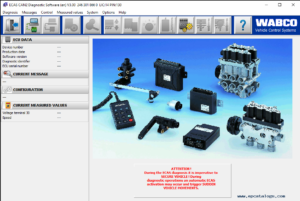If a driver reports a concern of coolant loss over time or coolant leaking through the expansion tank cap, then the reason could be air getting into the cooling system and causing excess pressure. This air can be originating from a failure in the air compressor or combustion gasses. A methodical but simple process of elimination will be necessary to identify the source of this concern.
The first step in diagnosis is to inspect and verify whether there are combustion gasses present in the coolant, with the help of a combustion leak tester, often referred to as a “block tester”. A fluid is used by the block tester which changes its color when exposed to combustion gasses or hydrocarbons, this gives a reliable means to confirm the presence of combustion gasses in the coolant. A block tester kit can be sourced locally or online. See the instructions for the particular tester that is being used. The fluid usually will change its color from blue to green during a typical positive test result.
There may be an issue with the air compressor if air bubbles and/or pressurization are present in the cooling system even if there are no combustion gasses present. The discharge line must be disconnected from the compressor as this will prevent the increase in air pressure, doing so will eliminated this component as a possible cause. There exist an internal failure within the air compressor, in case there is significant decrease in the presence of bubbles and/or pressurization.
If separating the air compressor does not reduce the concern, or it is confirmed that there are combustion gasses in the coolant, then a process must be used for elimination to identify the source.
Below mentioned are the component failures that can introduce gasses into the coolant and investigate them as per the given sequence:
- An internally leaking EGR cooler
- A leaking injector sleeve
- A blown cylinder head gasket
- A crack in the cylinder head
- A crack in a cylinder liner
EGR cooler
Remove the EGR cooler and pressure test it prior to performing any invasive disassembly of the engine. Firstly pressure test the EGR cooler while it is cold with the help of the procedure and tools referenced in the corresponding service information. Submerge the EGR cooler in hot water and then perform the test again, in case no leaks are found. Many a times a leak can be identified when the metal expands. The EGR cooler must be tested under conditions that are very closely resembling the normal operation.
Injector sleeves
Remove all six injectors and pressurize the cooling system, in case the EGR cooler passes the pressure test. Inspect the injector sleeves around the tops for any signs of coolant. Look into the cylinders with the help of a borescope or flashlight for any evidence of coolant dripping down onto a piston. In case any leak is detected in the injector cups, then cylinder head will required to be replaced, as the injector cups are not serviceable.
Note: If cylinder head replacement or additional troubleshooting is needed beyond this point, it is recommended to request an authorized OEM Service Center for further assistance. Any diagnostic or repair instructions provided by the service center will supersede the guidelines mentioned in this document.
Cylinder head gasket
Remove the cylinder head for further inspection, if there is no leakage in the injector sleeves. After removing the cylinder head, inspect for any sign of corrosion on the engine block, cylinder head sealing surfaces and cylinder head gasket, or scorching to the fire rings. An indication of a head gasket failure can be determined by looking for discoloration on the head gasket and the liner flange this occurs when coolant and combustion gasses combine at the failed area.
See Height Cylinder Liner, STD (Basic Assembly) and then measure and note down the liner heights according to the specifications and table in the Technical data section.
Cylinder head
See Check Cylinder Head, Engine (Basic Assembly) for information on inspection and pressure testing procedures. Ensure to click photos of any cracks that are detected in the cylinder head, which will most likely to occur between the valves, but could be hard to see with the naked eye. The cylinder head will need to be replaced if any cracks are detected as it is not serviceable. Use of a liquid magnetic particle penetrant or Aerosol like Magnaflux will increase the success in visually detecting cracks.
Visually inspect for any signs of cracks on the inside of the cylinder liners. Bar the engine over (if needed) to position the pistons at bottom dead center while performing this step. Magnaflux can also be utilized during this step.
Diagnostics
For further diagnosis, and to perform other tasks – Paccar Davie 4 is the factory software that is used.
Additional support
In case of any doubt on how to proceed with any step, update OEM software to provide detailed and accurate documentation of the information, pictures, and measurements that are gathered. Using this information the VSC along with RESM can suggest the best repair strategy for current situation



